Lessons learned with asyncio
(“Look ma, I wrote a distributed hash table!”)
What does asyncio do..?

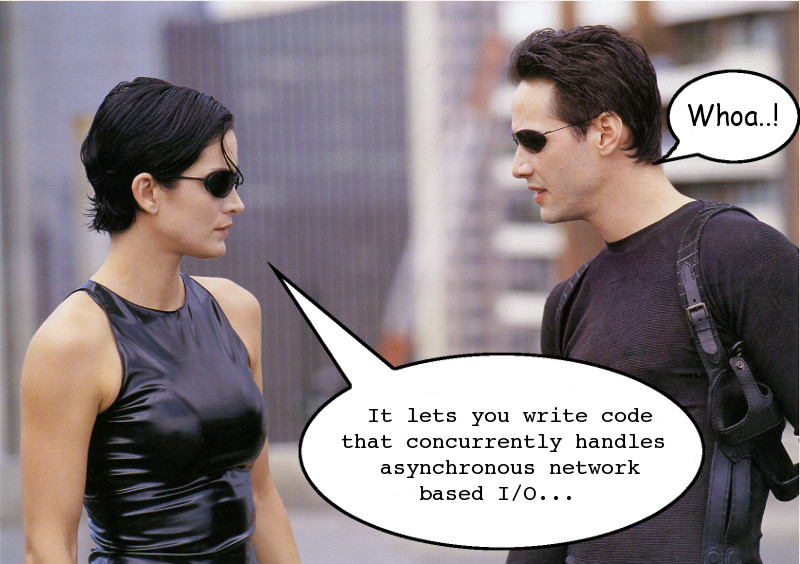
A problem clearly stated:
Messages arrive and depart via the network at unpredictable times - asyncio lets you deal with such interactions simultaneously.
What is a Distributed Hash Table?
Hash Table = dict (in Python)
>>> home = {}
>>> home['ntoll'] = 'Towcester'
>>> home['voidspace'] = 'Bugbrooke'
>>> home['pinner'] = 'Coventry'
>>> home
{
'ntoll': 'Towcester',
'voidspace': 'Bugbrooke',
'pinner': 'Coventry'
}
>>> home['ntoll']
'Towcester'
A very simple key / value data store.
Distributed

Decentralized
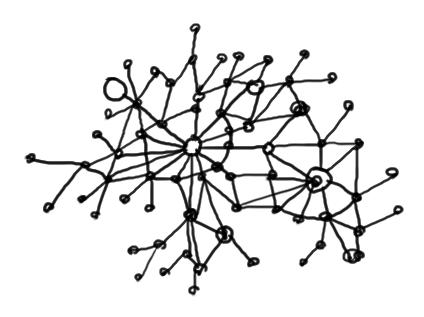
A distributed hash table (DHT) is a peer-to-peer key / value data store
How?
Core Concept #1
The Event Loop

(Based on real events - participants have been replaced by unreasonably happy actors)
IMPORTANT!
PEP 315 states that callbacks are...
“[...] strictly serialized: one callback must finish before the next one will be called. This is an important guarantee: when two or more callbacks use or modify shared state, each callback is guaranteed that while it is running, the shared state isn't changed by another callback.”
Hang on a minute..?
That doesn't sound very concurrent!
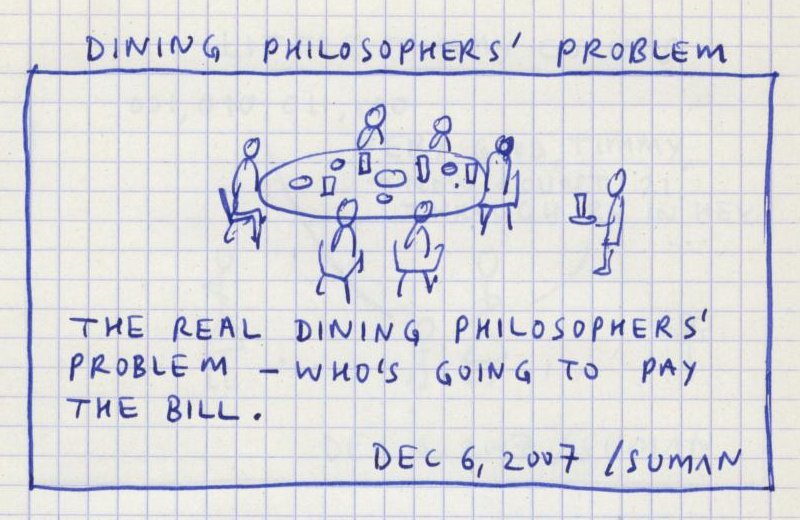
Concurrent tasks interfere with shared resources
- Task A reads a record.
- Task B reads a record.
- Both A and B change the retrieved data in different ways.
- Task B writes its changes.
- Task A writes its changes.
Task A overwrites the record containing task B's changes.
Act synchronously to avoid interference!
- First do A, then B followed by C (and so on).
- Easy to understand and deterministic.
- What happens if A needs to wait for something, for example, a reply from a machine on the network?
- The program waits until A's network call completes.
It can't get on with other stuff while waiting for A.
:-(
Welcome to the most important slide of this talk
- The program does not wait for a reply from network calls before continuing.
- Programmers define callbacks to be run when the result of a network call is known.
- In the meantime the program continues to poll for and respond to other network related I/O events.
- Callbacks execute during the iteration of the event loop immediately after the expected network I/O event is detected.
Confused..?
Don't be, its exactly how humans think about concurrency.

We make plans: when the washing machine finishes, take the clothes and hang them out to dry.

As humans we work on concurrent tasks (like preparing breakfast) in a similar non-blocking manner.
asyncio avoids potentially confusing and
complicated “threaded” concurrency while
retaining the benefits of strictly sequential code.
Questions:
- How are asynchronous concurrent tasks created?
- How do such tasks pause while waiting for non-blocking network based I/O?
- How are callbacks defined (to handle the eventual result)?
You need to understand coroutines, futures and tasks.
Core Concept #2
Coroutines
(Are FUN!)
- Coroutines are generators
- They may be suspended (yield from)
- They 'yield from' other objects
- At the end of the chain is an object that returns a result or raises an exception
@asyncio.coroutine
def handle_request(self, message, payload):
""" Handle an incoming HTTP request. """
response_code = 405 # Method Not Allowed
response_data = None
if message.method == 'POST':
try:
raw_data = yield from payload.read()
response_data = yield from self.process_data(raw_data)
response_code = 200 # OK
except Exception as ex:
# Log all errors
log.error(ex)
response_code = 500 # Internal Server Error
# etc...
return response
But what about callbacks?
How do I handle the result of a coroutine?
Core Concepts #3 & #4
Futures and Tasks
(Are also FUN!)
def handle_resolved_future(future):
"""
This function is a callback. Its only argument is the
resolved future whose result it logs.
"""
log.info(future.result())
# Instantiate the future we're going to use to represent the
# as-yet unknown result.
my_future = asyncio.Future()
# Add the callback to the list of things to do when the
# result is known (the future is resolved).
my_future.add_done_callback(handle_resolved_future)
(Time passes)
# in some coroutine that has the Future referenced
my_future.set_result('A result set some time later!')
def handle_resolved_task(task):
"""
This function is a callback. Its only argument is the
resolved task whose result it logs.
"""
log.info(task.result())
task = asyncio.Task(slow_coroutine_operation())
task.add_done_callback(handle_resolved_task)
loop = asyncio.get_event_loop()
try:
loop.run_until_complete(task)
finally:
loop.close()
No need to resolve the task in a coroutine!
First class functions
my_future.add_done_callback(handle_resolved_future)
First class function calls
add_generic_callbacks_to(my_future_or_task)
Recap...
(The Story So Far)
A DHT Example
Hashing, distance and lookups
A clock face of nodes

Node ID is derived from a Hash and indicates its location
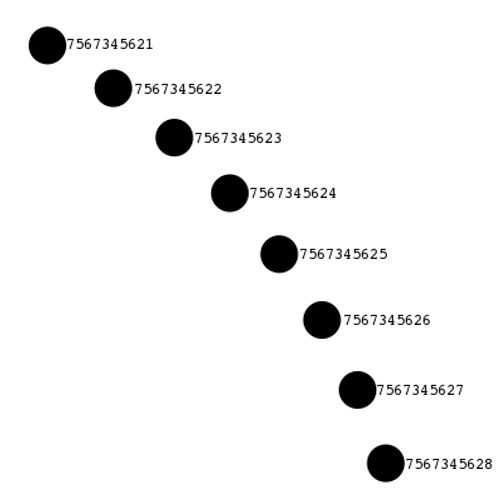
Each node has a unique id that is within a set of all possible values for a certain hash function (for example, sha512).
The id's value indicates the node's position in the clock-face.
In this way we can tell where a node is located in the abstract network, who it is close to and how far away nodes are from each other (there is some notion of distance).
Items are a Key / Value Pair
>>> from hashlib import sha512
>>> item = {
... 'my_key': 'Some value I want to store'
... }
>>> sha512('my_key').hexdigest()
'176b1c65a58c69bb83cf0f9e06695c4094bc35e69f2576464a027fa52fa53a7a
b35c2b4a39203aff98606aed641f45abbc0d39d2be0723f44cc04e9b3e7e0f87'
Data is a key / value pair.
The key is turned into a hash. The value is stored at nodes whose IDs are close to the hash of the key.
Aardvark belongs...

Its similar to understanding where to look things up in a multi-volume encyclopedia.
Articles are words (keys) and associated definitions (values) that are stored in volumes that cover some alphabetical range.
... under "A"

But, Zebra belongs...

... under "Z"

Tracking via the Routing Table

How do nodes know where to look..?
Each node maintains a local "routing table" that tracks the state of its peers.
Interactions give tracking data

(ID, IP address and port etc...)
All interactions result in the exchange of status information between nodes - that's how the routing table is populated and kept up-to-date..
Peers stored in fixed size buckets
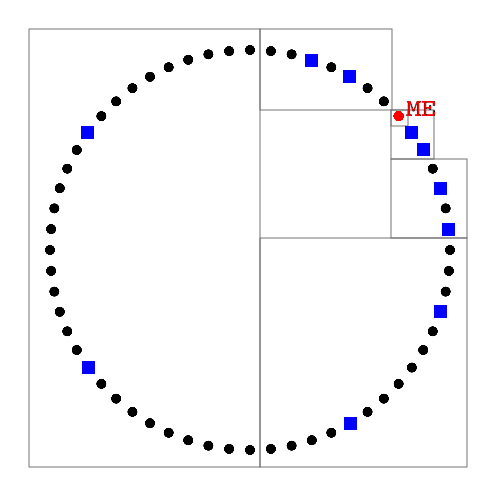
The routing table splits up the "clock face" of nodes into buckets.
- Buckets contain the same number of peers;
- Buckets cover a smaller range the closer to the local node they are;
- Ergo, the local node knows more closer nodes.
Simple rules
For the purposes of housekeeping:
- Reply with a value or X closest peers
- Ignore unresponsive peers
- Refresh the Routing Table
- Re-publish items
- etc...
Each node behaves according to some very simple rules.
GET() & SET() require a lookup.
All interactions are asynchronous.
Lookups are also
parallel (concurrent).
Lookup is a fundamental action for a DHT.
It's how to work out which peers are to be contacted to get or store a value.
A lookup is concurrent because several peers can be interrogated at once for this information.
Recursive Lookup

Here's how it works.
Six degrees of separation
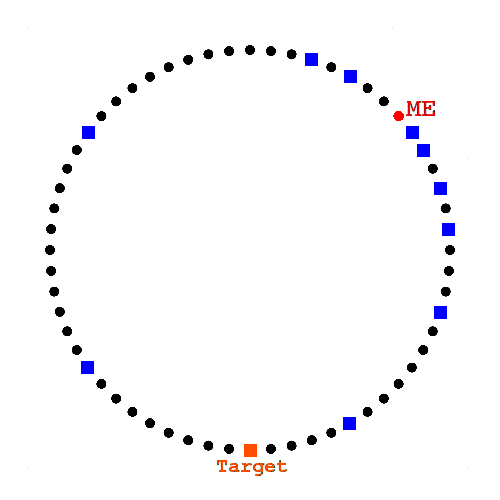
Say I want to put a value with a key whose hash puts it in a position close to 6 o'clock.
Ask closest known peers
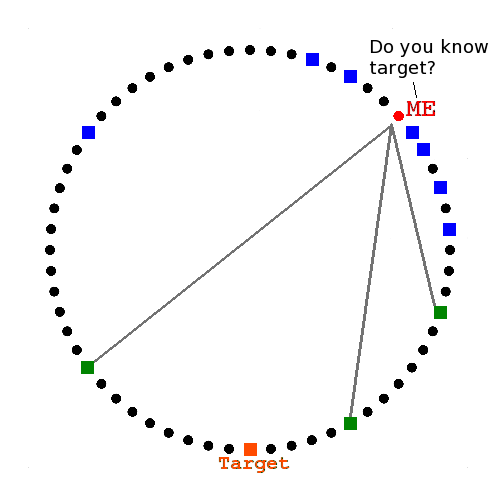
They reply with closer peers
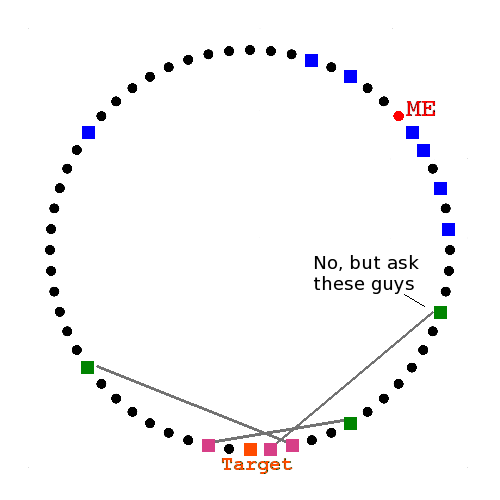
They reply with the target
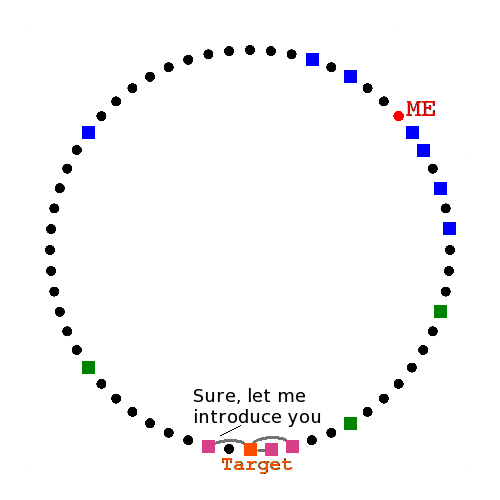
The lookup ends when I can't find any nodes closer to the target key.
GET() & SET() require a lookup.
All interactions are asynchronous.
Lookups are also
parallel (concurrent).
How is this handled within the realm of asyncio..?
Lookup is a Future
class Lookup(asyncio.Future):
"""
Encapsulates a lookup in the DHT given a particular target
key and message type. Will resolve when a result is found
or errback otherwise.
"""
def __init__(self, key, message_type, node, event_loop):
"""
key - sha512 of target key.
message_type - class to create inter-node messages.
node - the local node in the DHT.
event_loop - the event loop.
"""
...etc...
A lookup is something whose result we can't yet know (until we've finished looking it up).
Lookup is a Future
my_lookup = Lookup(key, FindValue, my_node, my_event_loop)
def got_result(lookup):
""" Naive callback """
result = lookup.result()
if isinstance(lookup.message_type, FindValue):
for remote_node in result:
# result is a list of closest nodes to "key".
# PUT the value at these nodes.
...etc...
else:
# result is a value stored at the location of "key"
...etc...
my_lookup.add_done_callback(got_result)
The state of the lookup (the progess of finding nodes close to the target) is held within the Lookup instance. It resolves with the result.
The result is either a value or not_found exception in the case of a GET(), or a list of closest known nodes in the case of a PUT().
What about Networking?
How does asyncio handle different networking protocols?
How do nodes on the DHT handle the "down the wire" aspect of I/O..?
Core Concepts #5 & #6
Transports and Protocols
(Are also a lot of FUN!)
Transports are provided by asyncio to
handle TCP, UDP etc. They are handle the low level I/O
layer and buffering and the event loop sets these up.
Protocols handle network protocols at the application layer (e.g. HTTP or netstring).
Transports

Transports are concerned with how stuff moves over the network.
Protocols

Protocols work out what to do with the stuff sent over the network. They work out how to turn the raw bytes into some meaningful message (such as a netstring)
You only need to work with Protocols.
class NetstringProtocol(asyncio.Protocol):
"""http://cr.yp.to/proto/netstrings.txt"""
def data_received(self, data):
"""
Called whenever the local node receives data from the
remote peer.
"""
self.__data = data
try:
while self.__data:
if self._reader_state == DATA:
self.handle_data()
elif self._reader_state == COMMA:
self.handle_comma()
elif self._reader_state == LENGTH:
self.handle_length()
else:
msg = 'Invalid Netstring mode'
raise RuntimeError(msg)
except NetstringParseError:
self.transport.close()
All protocol classes must override the data_received method to handle the incoming bytes.
My DHT is network agnostic so it can communicate via HTTP or Netstring.
Taken directly from Twisted. Very close. In fact asyncio transport/protocol is based upon how Twisted works in this way.
Final thoughts...
- Twisted..?
- 100% unit test coverage
- DHT < 1000 loc
- IO vs CPU bound
I love Twisted, the DHT was originally written using it. Very close. Asyncio feels more lightweight and Pythonic.
Testing is "normal" although how you organise your code is a key factor.
Asyncio makes it easy to think about concurrent problems. I believe the abstractions make it easy to write simple, short and comprehensible solutions.
DON'T USE ASYNCIO if you need to do something with lots of CPU overhead - it'll block the event loop!
Fin

That's it! My DHT project is called the drogulus.

Questions..?
